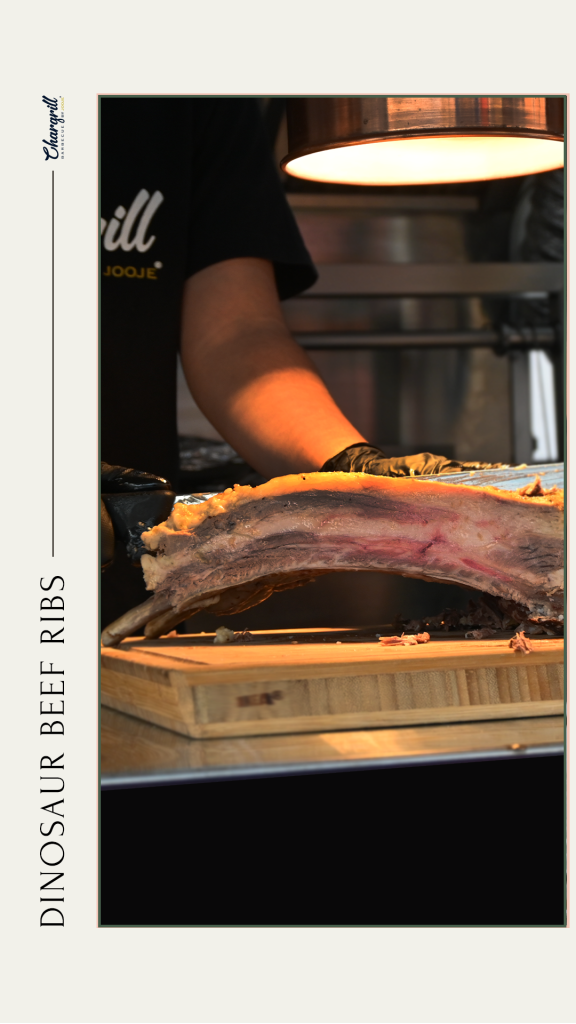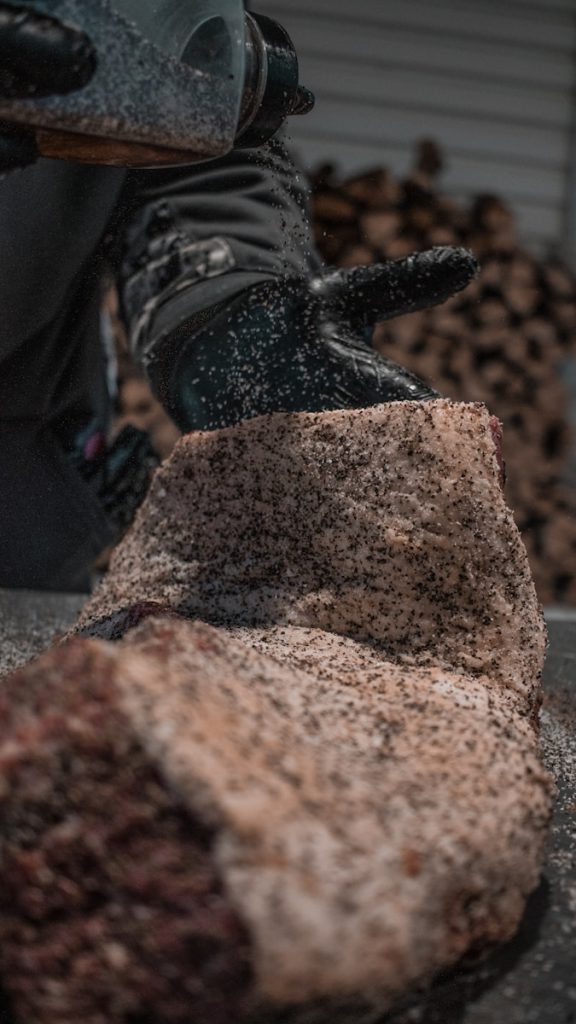Maintaining food quality during on-site catering is essential to ensure customer satisfaction and uphold the reputation of your catering business. The following guide provides comprehensive strategies and best practices to help you maintain the highest standards of food quality during on-site catering events.
Pre-Event Preparation
Proper menu planning is the cornerstone of successful on-site catering. It involves selecting dishes that maintain their quality throughout the transportation and serving process. Consider the following aspects:
- Choose Suitable Dishes: Opt for dishes that can withstand transportation and holding times without compromising quality. Avoid items that are highly perishable or delicate.
- Balance Hot and Cold Items: Incorporate a mix of hot and cold dishes to ease the burden on heating equipment and ensure variety.
- Seasonal Ingredients: Use fresh, seasonal ingredients for optimal taste and quality. Seasonal ingredients are often more flavourful and can be more cost-effective.
Table: Example of Balanced Menu Planning
| Dish Type | Examples | Notes |
|---|---|---|
| Hot Entrees | Smoked brisket, grilled chicken | Use insulated containers for transport |
| Cold Entrees | Caesar salad, pasta salad | Keep in coolers with ice packs |
| Sides | Garlic mashed potatoes, coleslaw | Chafing dishes for hot sides, coolers for cold |
| Desserts | Chocolate mousse, fruit platter | Serve desserts just before the end of the meal |
Food Preparation
Preparing food in advance and using efficient techniques is crucial for maintaining quality:
- Advanced Prep Work: Complete as much prep work as possible before the event, such as chopping vegetables, marinating meats, and preparing sauces. This reduces the workload on-site and ensures consistency.
- Batch Cooking: Cook food in batches to prevent overcooking and ensure consistent quality. This method also allows you to serve freshly cooked items.
- Cryovac Packing: For BBQ items, use cryovac packing to preserve freshness and flavour during transportation. This method locks in moisture and prevents spoilage.
List: Benefits of Advanced Preparation
- Reduces on-site workload
- Ensures consistency in taste and presentation
- Minimizes the risk of errors during the event
- Saves time and allows for efficient service

Equipment and Transportation
Investing in the right equipment is vital for maintaining food quality during transport and service:
- Chafing Dishes: Use chafing dishes to keep food warm on-site. They are ideal for buffets and ensure that hot foods remain at a safe temperature.
- Coolers and Insulated Containers: Store cold items in coolers with ice packs or insulated containers to maintain their temperature.
- Portable Cooking Equipment: Portable stoves, ovens, or grills are essential for on-site cooking and reheating, allowing you to serve freshly cooked dishes.
Table: Essential Equipment Checklist
| Equipment | Purpose | Example |
|---|---|---|
| Chafing Dishes | Keep food warm | Stainless steel chafing dishes with lids |
| Insulated Containers | Maintain cold food temperatures | Coolers with ice packs, thermal bags |
| Portable Cooking Gear | On-site cooking and reheating | Portable gas stove, electric grill |
| Food Thermometers | Temperature monitoring | Digital food thermometers |
| Handwashing Stations | Hygiene maintenance | Portable handwash stations |
Transportation Tips
Proper transportation techniques ensure food arrives safely and in optimal condition:
- Proper Packaging: Securely pack food items to prevent spillage and contamination. Use airtight containers and wrap items to keep them intact.
- Temperature Control: Use refrigerated vans or temperature-controlled containers for transporting perishable items. Maintain hot foods above 60°C and cold foods below 5°C.
- Efficient Loading: Load vehicles in a way that allows easy access to food items while maintaining their integrity. Separate hot and cold items to prevent temperature fluctuations.
List: Best Practices for Food Transportation
- Label containers clearly to avoid confusion on-site
- Use shock-absorbent materials to prevent movement during transit
- Schedule transportation to minimize time food spends in transit
- Monitor temperatures throughout the journey
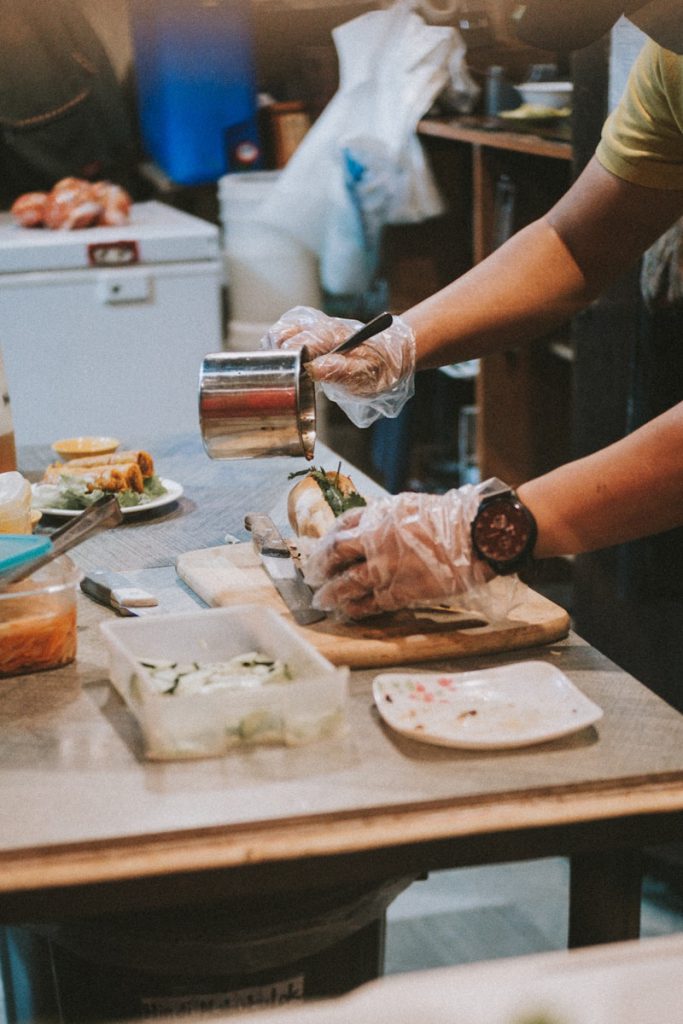
On-Site Setup: Setting Up the Kitchen
A well-organized kitchen setup is crucial for smooth operations and maintaining food quality:
- Designated Areas: Create designated areas for food preparation, cooking, and plating. This organization helps streamline workflow and prevents cross-contamination.
- Hygiene Stations: Set up handwashing stations and sanitizing supplies for staff. Regular handwashing is essential for food safety.
- Waste Management: Have bins available for waste disposal and recycling to maintain a clean working environment.
Table: On-Site Kitchen Setup
| Area | Purpose | Example Setup |
|---|---|---|
| Prep Area | Chopping, mixing, and marinating | Large tables, cutting boards, knives |
| Cooking Area | Cooking and reheating | Portable stove, grill, oven |
| Plating Area | Assembling and garnishing dishes | Serving trays, garnishing supplies |
| Hygiene Station | Handwashing and sanitizing | Handwash station, sanitizer |
| Waste Management | Disposal of waste | Trash bins, recycling bins |
Food Station Layout
Effective food station layout ensures a smooth flow of service and maintains food quality:
- Logical Flow: Arrange food stations in a logical flow to prevent bottlenecks and ensure smooth service. Place appetizers first, followed by main courses, sides, and desserts.
- Temperature Maintenance: Position heating and cooling equipment strategically to maintain proper food temperatures. Keep hot foods together and cold foods in a separate area.
- Presentation: Ensure food is attractively presented to enhance the dining experience. Use garnishes and decorative elements to make dishes visually appealing.
List: Tips for Food Station Layout
- Use signage to guide guests through the stations
- Keep serving utensils separate for each dish
- Refill stations regularly to ensure food availability
- Monitor temperatures and replenish ice or heat as needed
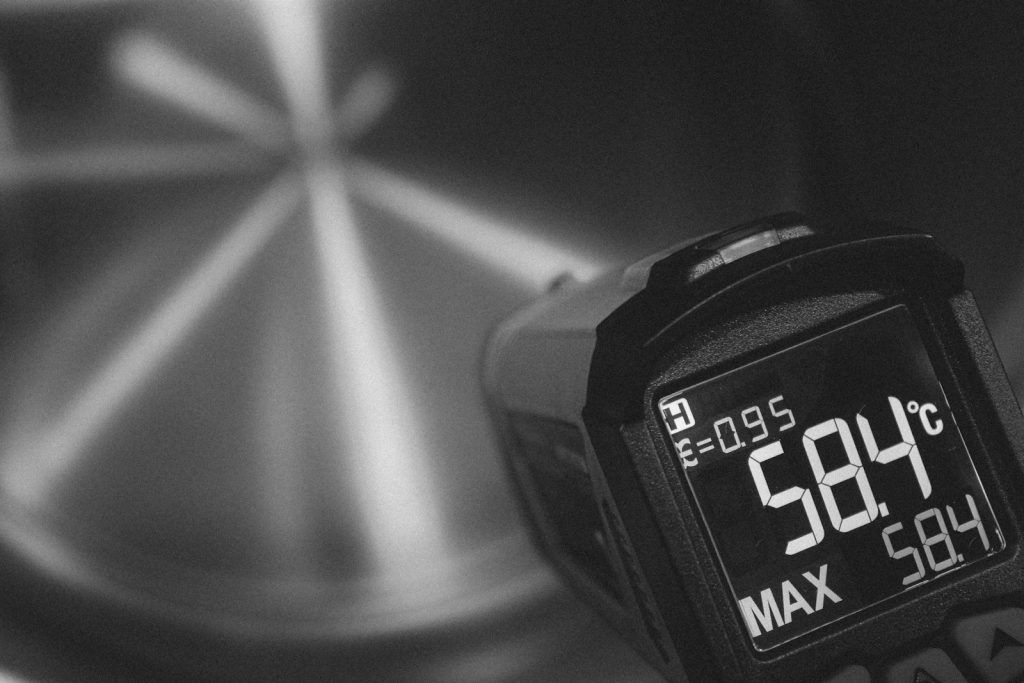
Temperature Control
Maintaining the correct temperature is critical for food safety and quality:
Hot Holding
- Chafing Dishes and Warmers: Use chafing dishes and food warmers to keep hot dishes at safe temperatures. These devices are essential for buffet-style service.
- Regular Monitoring: Frequently check and record the temperatures of hot dishes to ensure they remain above 60°C. Use digital thermometers for accuracy.
Table: Hot Holding Equipment
| Equipment | Purpose | Example Use |
|---|---|---|
| Chafing Dishes | Keep food warm | Buffet setups for hot entrees and sides |
| Heat Lamps | Maintain heat for dishes | Carving stations, hot food displays |
| Insulated Carriers | Transport hot food | Delivery to remote sites |
Cold Holding
- Coolers and Ice Baths: Store cold dishes in coolers with ice packs or in ice baths to maintain their temperature. This is crucial for salads, desserts, and beverages.
- Temperature Checks: Regularly monitor and record the temperatures of cold dishes to ensure they remain below 5°C. Adjust ice packs and ice baths as needed.
List: Cold Holding Techniques
- Use insulated containers for transportation and storage
- Keep lids closed to retain cold temperatures
- Replenish ice packs and ice baths regularly
- Monitor and record temperatures frequently
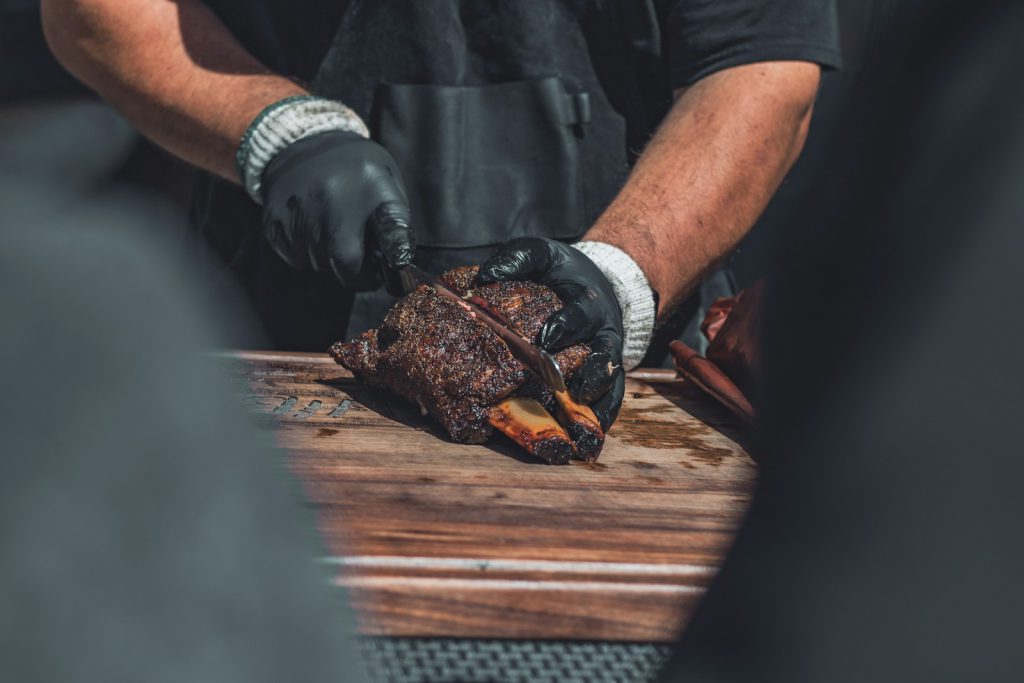
Food Safety and Hygiene
Proper training for staff ensures they understand and implement food safety practices:
- Food Safety Certification: Ensure all staff have proper food safety training and certification. This education covers critical areas like safe food handling, hygiene practices, and temperature control.
- Hygiene Practices: Train staff on handwashing, glove use, and preventing cross-contamination. Emphasize the importance of maintaining cleanliness throughout the event.
- Sick Policy: Implement a policy that requires staff to report illnesses and stay home when sick. This policy helps prevent the spread of illness through food.
Table: Staff Training Components
| Training Area | Key Points | Example Practices |
|---|---|---|
| Food Handling | Safe preparation and storage | Washing hands, wearing gloves |
| Hygiene Practices | Personal and kitchen hygiene | Regular handwashing, clean uniforms |
| Temperature Control | Monitoring and recording temperatures | Using food thermometers |
| Cross-Contamination | Preventing contamination | Separate raw and cooked foods |
| Illness Reporting | Reporting and managing illnesses | Staff to notify management when ill |
On-Site Practices
Implementing strict on-site practices helps maintain food safety and quality:
- Clean Work Surfaces: Regularly clean and sanitize work surfaces and utensils. Use food-safe sanitizers and maintain a cleaning schedule.
- Proper Storage: Store raw and cooked foods separately to prevent cross-contamination. Use labeled containers and keep them at appropriate temperatures.
- Pest Control: Take measures to prevent pests from accessing the food preparation area. Use covers and screens, and maintain cleanliness to deter pests.
List: Essential On-Site Hygiene Practices
- Wash hands before and after handling food
- Use separate cutting boards for raw and cooked foods
- Keep food covered to protect from contamination
- Dispose of waste promptly to avoid attracting pests

Service and Presentation
Professional and knowledgeable serving staff enhance the guest experience and contribute to maintaining food quality:
- Uniforms and Appearance: Ensure staff wear clean uniforms and maintain quality a professional appearance. This helps build a positive impression and ensures hygiene standards are upheld.
- Service Etiquette: Train staff on proper serving etiquette and customer interaction. Friendly, efficient service can significantly enhance the dining experience.
- Food Knowledge: Equip staff with knowledge about the menu to answer guest questions confidently. They should be familiar with ingredients, preparation methods, and any potential allergens.
Table: Staff Training Areas
| Training Area | Key Components | Benefits |
|---|---|---|
| Uniforms and Appearance | Clean, professional attire, name badges | Enhances professionalism and hygiene |
| Service Etiquette | Polite interaction, attentive service | Improves guest satisfaction |
| Food Knowledge | Menu details, dietary information | Ensures accurate information for guests |
Presentation Techniques
Attractive food presentation is crucial for creating a memorable dining experience:
- Garnishing: Use fresh herbs and garnishes to enhance the visual appeal of dishes. This adds color and texture, making the food more enticing.
- Buffet Setup: Arrange food on buffets in an attractive and accessible manner. Use varying heights and decorative elements to create visual interest.
- Signage: Use clear signage to label dishes, including dietary information such as gluten-free or vegetarian options. This helps guests make informed choices.
List: Tips for Effective Food Presentation
- Use colorful garnishes to brighten up dishes
- Arrange food neatly and in small batches to maintain freshness
- Label dishes clearly, especially for dietary restrictions
- Use high-quality serving ware and utensils
Managing Special Dietary Requirements
Accommodating special dietary requirements is essential for guest satisfaction and safety:
Menu Adaptations
Offering a variety of menu options ensures all guests can enjoy the meal:
- Allergen-Free Options: Provide options for common allergens like nuts, dairy, and gluten. Clearly label these dishes to prevent any confusion.
- Dietary Preferences: Offer vegetarian, vegan, and other dietary preference options. Make sure these dishes are as appealing and flavourful as the main menu items.
- Cross-Contamination Prevention: Take steps to prevent cross-contamination when preparing and serving allergen-free dishes. Use separate utensils and preparation areas if possible.
Table: Dietary Accommodation Strategies
| Dietary Need | Menu Adaptation | Preparation Tip |
|---|---|---|
| Gluten-Free | Gluten-free bread, pasta alternatives | Use separate utensils and prep areas |
| Nut-Free | Nut-free desserts and snacks | Avoid using nuts in any dishes |
| Vegetarian/Vegan | Plant-based entrees and sides | Ensure no cross-contact with meat products |
| Dairy-Free | Use dairy alternatives (e.g., almond milk) | Clearly label and separate from dairy items |
Cross-Contamination Prevention
Preventing cross-contamination is critical in managing dietary requirements:
- Separate Prep Areas: If possible, designate separate preparation areas for allergen-free foods.
- Dedicated Utensils: Use dedicated utensils for preparing and serving allergen-free dishes.
- Thorough Cleaning: Ensure all surfaces and equipment are thoroughly cleaned between uses to remove any potential allergens.
List: Best Practices for Cross-Contamination Prevention
- Clearly label and store allergen-free foods separately
- Train staff on the importance of avoiding cross-contact
- Regularly audit and review food handling practices
- Communicate dietary needs clearly to all team members

Guest Feedback and Quality Control
Collecting and acting on guest feedback helps improve your service and maintain high standards:
Gathering Feedback
Implement methods to gather valuable feedback from guests:
- Feedback Forms: Provide feedback forms for guests to fill out after the event. Include questions about food quality, service, and overall experience.
- Direct Interaction: Encourage staff to interact with guests and gather feedback during the event. This can provide immediate insights into guest satisfaction.
- Follow-Up: Reach out to clients post-event to gather more detailed feedback and address any concerns. This shows commitment to continuous improvement.
Table: Feedback Collection Methods
| Method | Description | Benefits |
|---|---|---|
| Feedback Forms | Written forms with specific questions | Provides structured, actionable feedback |
| Direct Interaction | Conversations between staff and guests | Offers immediate insights and engagement |
| Post-Event Follow-Up | Emails or calls to clients | Shows dedication to client satisfaction |
Continuous Improvement
Use feedback to drive continuous improvement in your catering services:
- Analyze Feedback: Regularly review feedback to identify areas for improvement. Look for common themes and specific suggestions.
- Staff Training: Provide ongoing training for staff based on feedback and identified needs. Address any gaps in knowledge or service.
- Quality Audits: Conduct periodic quality audits to ensure standards are consistently met. This includes reviewing food quality, service practices, and hygiene.
List: Steps for Continuous Improvement
- Implement changes based on guest feedback
- Recognize and reward staff for excellent performance
- Stay updated with industry trends and best practices
- Regularly review and update menus and service offerings
Case Studies and Success Stories
Case Study 1: Corporate Event Catering
- Event Details: A corporate client requested full-service catering for a day-long conference.
- Challenges: Maintaining food quality over multiple meal periods and accommodating dietary restrictions.
- Solutions: Implemented batch cooking, used high-quality insulated containers, and had a dedicated team for managing dietary requests.
- Outcome: The client praised the food quality and service, leading to repeat business.
Table: Corporate Event Success
| Aspect | Challenge | Solution | Outcome |
|---|---|---|---|
| Multiple Meal Periods | Keeping food fresh and appealing | Batch cooking, insulated containers | Consistently high-quality food |
| Dietary Restrictions | Accommodating various dietary needs | Dedicated team for dietary management | Satisfied guests with special needs |
| Client Feedback | Ensuring positive client experience | Continuous interaction and feedback | Repeat business from the corporate client |
Case Study 2: Outdoor Wedding
- Event Details: An outdoor wedding requiring a mix of BBQ and gourmet dishes.
- Challenges: Managing temperature control in an outdoor setting and ensuring timely service.
- Solutions: Set up a portable kitchen, used chafing dishes and coolers strategically, and had a well-organized serving team.
- Outcome: The couple and guests were delighted with the food, and the event ran smoothly.
Table: Outdoor Wedding Success
| Aspect | Challenge | Solution | Outcome |
|---|---|---|---|
| Outdoor Setting | Temperature control | Portable kitchen, chafing dishes, coolers | Maintained food quality |
| Timely Service | Efficient service delivery | Organized serving team | Smooth event flow |
| Guest Satisfaction | Positive guest experience | High-quality food and presentation | Delighted couple and guests |
Conclusion
Maintaining food quality during on-site catering involves meticulous planning, proper equipment, strict adherence to food safety practices, and attentive service. By following the strategies outlined in this guide, catering businesses can ensure their food remains delicious and safe, providing an exceptional dining experience for their clients. Through careful preparation, effective temperature control, and continuous improvement based on feedback, your catering service can consistently deliver high-quality meals that impress and satisfy guests.


